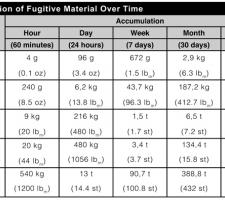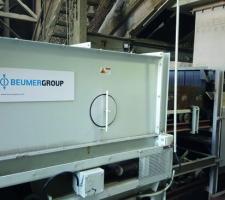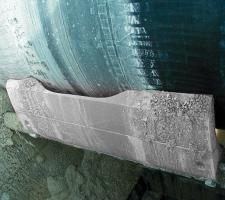
Conveyors are vital equipment in a quarry, transporting vast volumes of different sized crushed and screened aggregates products to stockpiles for further processing. Liam McLoughlin & Guy Woodford look at some of the latest developments in this area.
The first TR-75 and TC-100 tacked radial conveyors have come off the line at
Full production of the TR-75 and TC-100 conveyors follows thorough testing of prototype models by Terex customer D.K. Trotter & Sons at the company’s quarry in Manorhamilton, Co. Leith, Ireland.
The Terex TR-75 is a 22.9-metre long self-powered tracked radial conveyor with a 1,050mm belt said to offer a large stockpile capacity. It has a maximum discharge height of 10.9m and comes with crawler tracks with pendant control system and single radial wheel drive.
The Terex TC-100 follows on the successful launch of the TC-65 & TC-80 tracked conveyors. At 30 metres long, the extra length of the conveyor and increased power is said to allow for maximum mobility and flexibility, reducing or eliminating the use of wheeled loaders on site. Like the TR-75. the model has a belt width of 1,050mm, and a discharge height of 14.3m.
Terex says the TR-75 and TC-100 can cope with a range of applications, from screening light and fines materials to primary crushing applications.
Robust apron conveyors (SZFs) are used in cement plants to transport clinker safely and economically from the kiln cooling system to the silos. BEUMER claims to be the only manufacturer who offers a special variant, the belt apron conveyor (GSZF): using a belt instead of a chain as traction element allows higher speeds and a slimmer design while still delivering the same level of performance. The GSZF is therefore, says BEUMER, particularly suitable for modernisations.
In general, the clinker comes out of the cooler at 80° plus ambient temperature. But during the process, a so-called kiln flash can occur caused by a raw meal flash from the preheater tower or by caked clinker coming off the kiln: Within a few seconds several tonnes of raw meal or clinker shoot through the cooler. The material to be conveyed cannot cool down sufficiently and reaches the conveyor at temperatures of 500 to 800°C.
With its apron conveyors, BEUMER says it provides robust and reliable solutions. The specific design of the cells allows safe, low-friction transport of any hot material. Sealed and overlapping side walls and bottom plates in the cells prevent the clinker from exiting and minimise the escape of dust. The traction element in this conveyor is usually a single or double strand sprocket chain. The system supplier is the only manufacturer on the market who offers apron conveyors with the tried and tested BEUMER steel wire belts from the bucket elevator technology instead of a chain as traction element. Here the cells are attached to the long-lasting, steel-wire reinforced belt in a way so that the heat of the clinker in the steel cells is not transferred to the belt. Partition plates are attached in the feeding area below the cooler and can be easily removed for maintenance, protecting the belt against hot clinker in case of a kiln flash.
One decisive advantage of the belt apron conveyor, says BEUMER, is its speed of 0.6 metres per second, allowing it, the company says, to reach double the conveying speed compared to apron conveyors with a chain. This is said to make it perfect for retrofitting and modernisations. If operators want to increase the kiln capacity, for example, they can replace an existing chain apron conveyor with a belt version of the same size – this means double the capacity without having to make any changes to the steel structure or the conveyor bridge. The cement plants also benefit from a new construction application. The thinner, lighter design of the GSZF reduces costs for steel structure and freight. Furthermore, the decreased net weight lowers the static and dynamic loads which affect the clinker silo and foundations for example. A new construction project can be designed for a smaller load and is therefore said by BEUMER to be more cost-effective to build. The lightweight design also lowers operational costs.
The entire belt lies with its surface on the drive and return pulley, avoiding the unwanted polygon effects caused by the chain. The particularly smooth running of the machine also reduces noise emissions considerably. The noise is less than half as loud as conventional SZFs with chains, which is advantageous for both the employees and the environment.
The use of the durable BEUMER steel wire belt is said by the German manufacturer to lower maintenance costs, while, concurrently, extending maintenance intervals. Chains can break, if preventive maintenance is not performed properly, which will lead to the conveyor collapsing. The rubber of the steel wire belt only becomes brittle with age, but it would never completely break. Lubrication is also not required for the belt, whereas used frequently on a chain, if for no other reason than to reduce noise levels. BEUMER notes that grease and oil are not only a cost factor, but also detrimental to the environment and the conveyor. The clinker dust gets stuck on it and settles in the chain links, which accelerates the wear and tear.
Given the number of conveyor-related accidents that occur during routine maintenance and cleanup,
A company spokesperson says: “Seemingly mundane tasks such as adjusting belt cleaners and removing spillage often require employees to work in close proximity to the moving conveyor, where even incidental contact can result in serious injury in a split second. Further, spillage can contribute to the risk of fire by interfering with pulleys and idlers and by providing potential fuel. Even worse, in confined spaces, airborne particles can create the right ingredients for an explosion.”
The buildup of fugitive material can occur with surprising speed. As the Martin-supplied table below illustrates, spillage in an amount equal to just one sugar packet (about four grams) per hour will result in an accumulation of about 700 grams at the end of a week. If the rate of escape is four grams per minute, the accumulation will be more than 45kg per week, or more than two tonnes/year. If the spillage amounts to just one shovelful per hour (not an uncommon occurrence in some operations), personnel can expect to have to deal with more than 225kg of fugitive material every day.
The Martin spokesperson continued: “Although there are a number of belt-cleaning technologies available to conveyor operators, most designs in use today are blade-type units of some kind, using a urethane or metal-tipped scraper to remove material from the belt’s surface. These devices typically require an energy source - such as a spring, a compressed air reservoir or a twisted elastomeric element - to hold the cleaning edge against the belt. Because the blade directly contacts the belt, it is subject to abrasive wear and must be regularly adjusted and periodically replaced to maintain effective cleaning performance.
“The ability to maintain the proper force required to keep the blade edge against the belt is a key factor in the performance of any cleaning system. Blade-to-belt pressure must be controlled to achieve optimal cleaning with a minimal rate of blade wear. There is a popular misconception that the harder the cleaner is pressing against the belt, the better it will clean.
But research has shown that there is actually an optimum range of blade pressure, which will most effectively remove carryback material. Increasing tension beyond this range raises blade-to-belt friction, thus shortening blade life, increasing belt wear and increasing power consumption, without improving cleaning performance.”
Martin notes that operating a belt cleaner below the optimum pressure range also delivers less effective cleaning and can actually accelerate blade wear. The firm says a belt cleaner lightly touching the belt may appear to be in working order from a distance, whereas in reality, excessive amounts of carryback are being forced between the blade and the belt at high velocity. This passage of material between the belt and the blade creates channels of uneven wear on the face of the cleaner. As material continues to pass between the blade and the belt, these channels increase in size, rapidly wearing the blade to a jagged edge.
The Martin spokesperson said: “A common source of blade wear that often goes unnoticed - even with a properly installed and adjusted cleaner -- is running the belt empty for long periods of time. Small particles embedded in the empty belt’s surface can create an effect like sand paper, increasing the wear rate of both the blade and the belt. Even though the cargo may be abrasive, it often has moisture in it that serves as a lubricant and coolant.
“Another potential source of wear is when the cleaner blade is wider than the material flow, causing the outside portion of the cleaning blade to hold the centre section of the blade away from the belt. As a result, carryback can flow between the belt and the worn area of the blade, accelerating wear on this center section. Eventually, the process creates a curved wear pattern sometimes referred to as a ‘smiley face’ or ‘mooning.’”
Martin stress how as urethane cleaner blades wear, the surface area of the blade touching the belt increases. This causes a reduction in blade-to-belt pressure and a corresponding decline in cleaner efficiency. Therefore, most mechanically-tensioned systems require periodic adjustment (re-tensioning) to deliver the consistent pressure needed for effective carryback removal.
The company spokesperson said: “To overcome the problem of the blade angle changing as the blade wears, a radial-adjusted belt cleaner can be designed with a specially-engineered curved blade, known as “CARP” for Constant Angle Radial Pressure. With this innovative design, the changes in contact angle and surface area are minimised as the blade wears, helping to maintain its effectiveness throughout the cleaner’s service life.”
Martin stresses that new air-powered tensioning systems are automated for precise monitoring and tensioning throughout all stages of blade life, reducing the labour typically required to maintain optimum blade pressure and extending the service life of both the belt and the cleaner. Equipped with sensors to confirm that the belt is loaded and running, the devices automatically back the blade away during stoppages or when the conveyor is running empty, minimising unnecessary wear to both the belt and cleaner. The result is consistently correct blade tension, with reduced power demand on start-up, all managed without operator intervention. For locations lacking convenient power access, one self-contained design uses the moving conveyor to generate its own electricity, powering a small air compressor to maintain optimum blade pressure.
Even the best-designed and most efficient of mechanical belt cleaning systems require periodic maintenance and/or adjustment, or performance will deteriorate over time, explains Martin. Proper tensioning of belt-cleaning systems minimises wear on the belt and cleaner blades, helping to prevent damage and ensure efficient cleaning action. Belt cleaners must be engineered for durability and simple maintenance, and conveyors should be designed to enable easy service, including required clearances for access. Service chores that are straightforward and ‘worker-friendly’ are more likely to be performed on a consistent basis.
The Martin spokesperson continued: “The use of factory-trained and certified specialty contractors can also help ensure that belt cleaner maintenance is done properly, and on an appropriate schedule. Further, experienced service technicians often notice other developing system or component problems that can be avoided if they are addressed before a catastrophic failure occurs, helping conveyor operators avoid potential equipment damaging and expensive unplanned downtime. By setting the cleaning goal necessary for each individual operation and purchasing a system adequate for those conditions as laid out in CEMA standards, it’s possible to achieve carryback control and yet obtain long life from belt cleaners. The bottom line is that properly-installed and adjusted belt cleaners help minimise carryback and spillage, reducing risk and overall operating costs.”


















